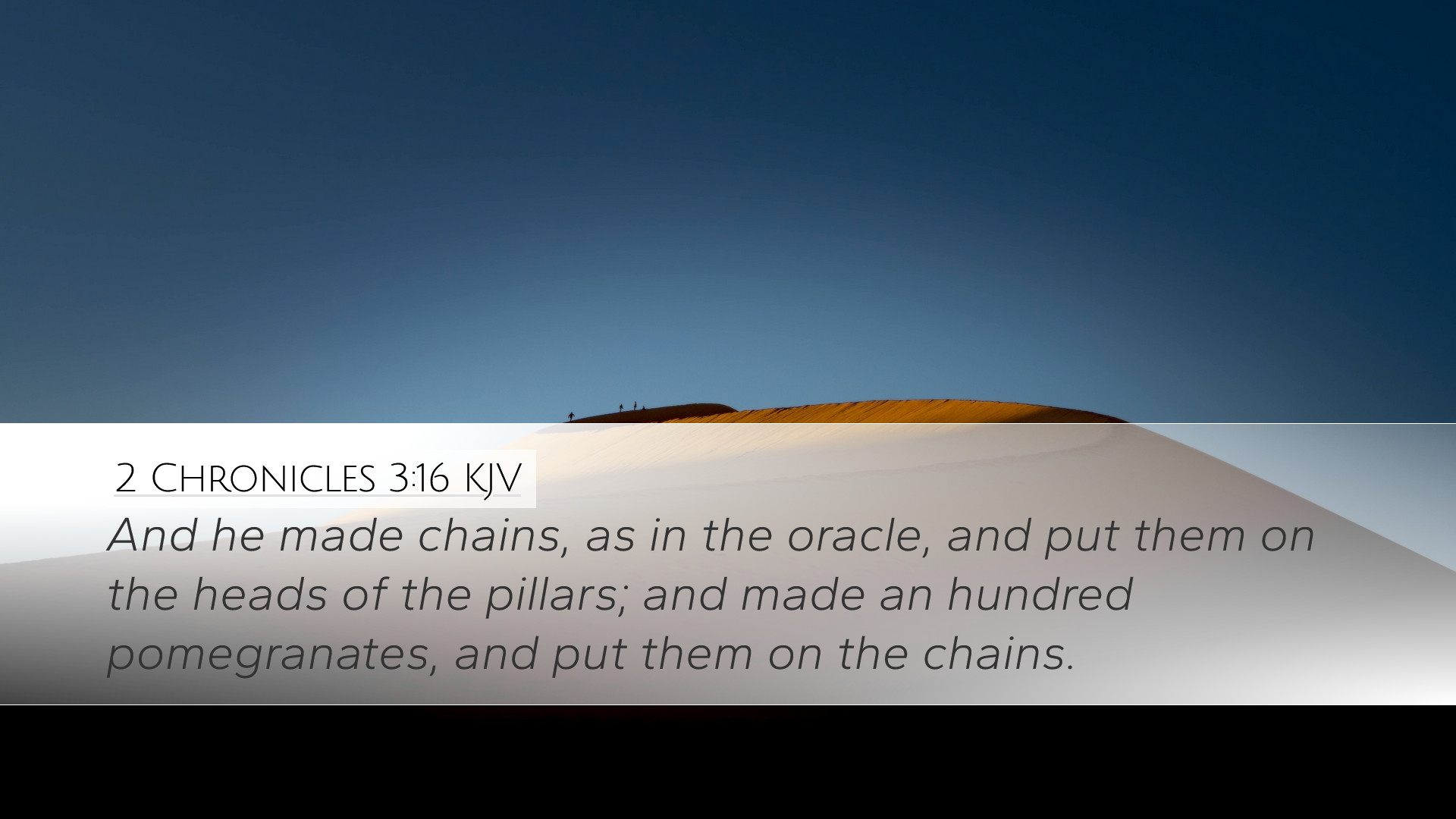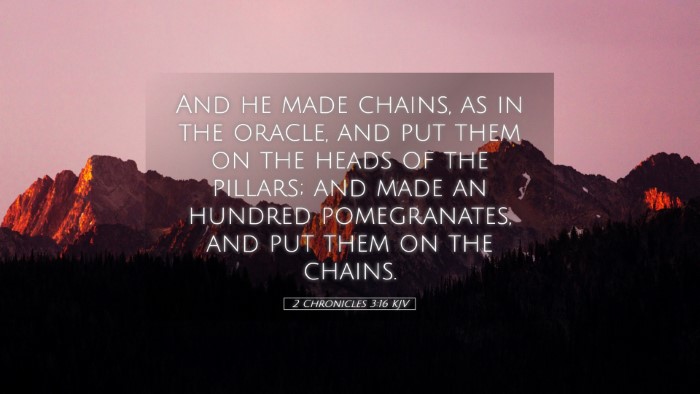Commentary on 2 Chronicles 3:16
Bible Verse: 2 Chronicles 3:16 - "And he made chains as in the oracle; and put them on the heads of the pillars; and made a hundred pomegranates, and put them on the chains."
Introduction
This verse, nestled within the account of Solomon's temple construction, offers a rich tapestry of theological, historical, and artistic insights. The intricacies of the items described, particularly the chains and pomegranates, reveal both the aesthetic and symbolic dimensions of worship in ancient Israel.
Exegesis of the Verse
In 2 Chronicles 3:16, we find a detailed description of the decorative elements of the temple's pillars, which were integral to Solomon's monumental construction project. Each element here holds significance that extends beyond its physical form.
The Chains
Chains as Symbols: The chains mentioned in this verse can signify the connection between the physical and the spiritual. They were used to fasten the ornamental pomegranates to the pillars, representing a link between sacred worship and the divine presence.
Matthew Henry's Insight: According to Matthew Henry, the chains symbolize the bonds that tie the worshippers to their faith and to God. They also reflect the importance of order and structure in worship, suggesting that true worship involves a commitment and dedication that binds together the community of believers.
The Pomegranates
Symbolism of Pomegranates: Pomegranates are often considered a symbol of abundance and fertility in biblical literature. Their placement on the pillars can signify the blessings and fruitful harvest that accompany a life lived in accordance with God's commandments.
Albert Barnes' Commentary: Barnes highlights that the pomegranates were designed to enhance the beauty of the temple and serve a decorative purpose that invites worshippers to reflect on God's generosity. This alignment of aesthetic beauty with spiritual meaning underscores the holistic nature of worship.
Theological Reflections
The intricate artistry of the temple, embodied in the chains and pomegranates, prompts deeper theological reflections.
- The Nature of God’s House: The temple is depicted as a place of both beauty and divine encounter. Each ornamentation serves not merely as decoration but as a conduit for approaching God.
- The Role of Humanity: The act of making and adorning the temple presents a partnership between God's power and human creativity. Solomon, as a builder, embodies the calling for humans to glorify God through their talents and resources.
Historical Context
Understanding this verse requires insight into the historical context of 2 Chronicles. Written during a time of restoration and reflection, it served to remind the people of Israel of their heritage and their covenant with God.
Adam Clarke's Perspective: Clarke suggests that the meticulous details reflect a desire to please God and honor the traditions that have been passed through generations. The act of building the temple becomes a national act that reaffirms the identity of the Israelites as God's chosen people.
Application for Today
The themes found in 2 Chronicles 3:16 resonate profoundly in contemporary settings. As pastors, students, and scholars reflect on this verse, several practical applications emerge:
- The Importance of Beauty in Worship: Modern worship spaces can draw lessons from the beauty of the temple’s design. Creating environments that inspire awe and reverence can enhance congregational worship.
- Collaborative Worship: The intertwining of divine and human efforts in the temple’s construction invites current leaders to view ministry as a collaborative endeavor.
- Symbolism in Ministry: The decorative elements remind believers to incorporate meaningful symbols in their practices of faith that convey deeper theological truths.
Conclusion
In summary, 2 Chronicles 3:16 serves as a profound reminder of the beauty, symbolism, and communal aspects of worship. By examining the intricate details of the temple's construction—specifically the chains and pomegranates—commentators illuminate the deeper spiritual truths woven into the fabric of Israel’s religious life. This passage invites us to reflect on our own worship practices and the ways we can glorify God through creativity, collaboration, and symbolism.


